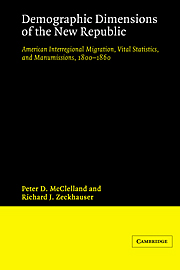 Demographic Dimensions of the New Republic
Demographic Dimensions of the New Republic Book contents
- Frontmatter
- Contents
- List of tables
- Preface
- Map 1 Regions of the United States
- 1 Introduction and summary
- 2 Migration model: closed population
- 3 Migration model: adjustments for international migration
- 4 Interregional migration estimates 1800–60
- 5 White population: birth rates, death rates, and rates of natural increase
- 6 Negro population: birth rates, death rates, rates of natural increase, and manumissions
- 7 Conclusions
- Appendixes
- Notes
- Bibliography
- Index
5 - White population: birth rates, death rates, and rates of natural increase
Published online by Cambridge University Press: 19 September 2009
- Frontmatter
- Contents
- List of tables
- Preface
- Map 1 Regions of the United States
- 1 Introduction and summary
- 2 Migration model: closed population
- 3 Migration model: adjustments for international migration
- 4 Interregional migration estimates 1800–60
- 5 White population: birth rates, death rates, and rates of natural increase
- 6 Negro population: birth rates, death rates, rates of natural increase, and manumissions
- 7 Conclusions
- Appendixes
- Notes
- Bibliography
- Index
Summary
Overview: 1800–60
Among the puzzles raised by the demographic statistics for the American white population of this period, two are particularly noteworthy. The first, as indicated at the outset of this study, is how exceptional the growth record was by contemporary world standards. The main explanation of this record, as documented by previous immigration calculations, was the exceptional rate of natural increase of the local population. The second concerns the sharp discontinuity in estimated rates of natural increase, a discontinuity that remains for all reasonable variations in the assumptions underlying these estimates. Why was the domestic rate of natural increase so atypical, and what caused it to change so dramatically in the period 1800–1860?
That American birth rates were exceptionally high in the latter part of the eighteenth century was a commonplace among contemporary observers. Their explanations stressed abundant land, high living standards and a propensity to marry early. Death rates were ‘low’. The rural and dispersed population was better fed and less subject to contagious and infectious diseases – or so the argument ran. Whether death rates were considered to be unusually depressed by European or world standards is not clear. The exceptional nature of birth rates was never questioned.
American demographers are agreed that during the first half of the nineteenth century birth rates fell quite rapidly. Such factors as urbanization, rising incomes, and changing land availability are usually cited as contributing to a rise in marriage age and a fall in the incidence of marriage.
- Type
- Chapter
- Information
- Demographic Dimensions of the New RepublicAmerican Interregional Migration, Vital Statistics and Manumissions 1800-1860, pp. 54 - 72Publisher: Cambridge University PressPrint publication year: 1983


